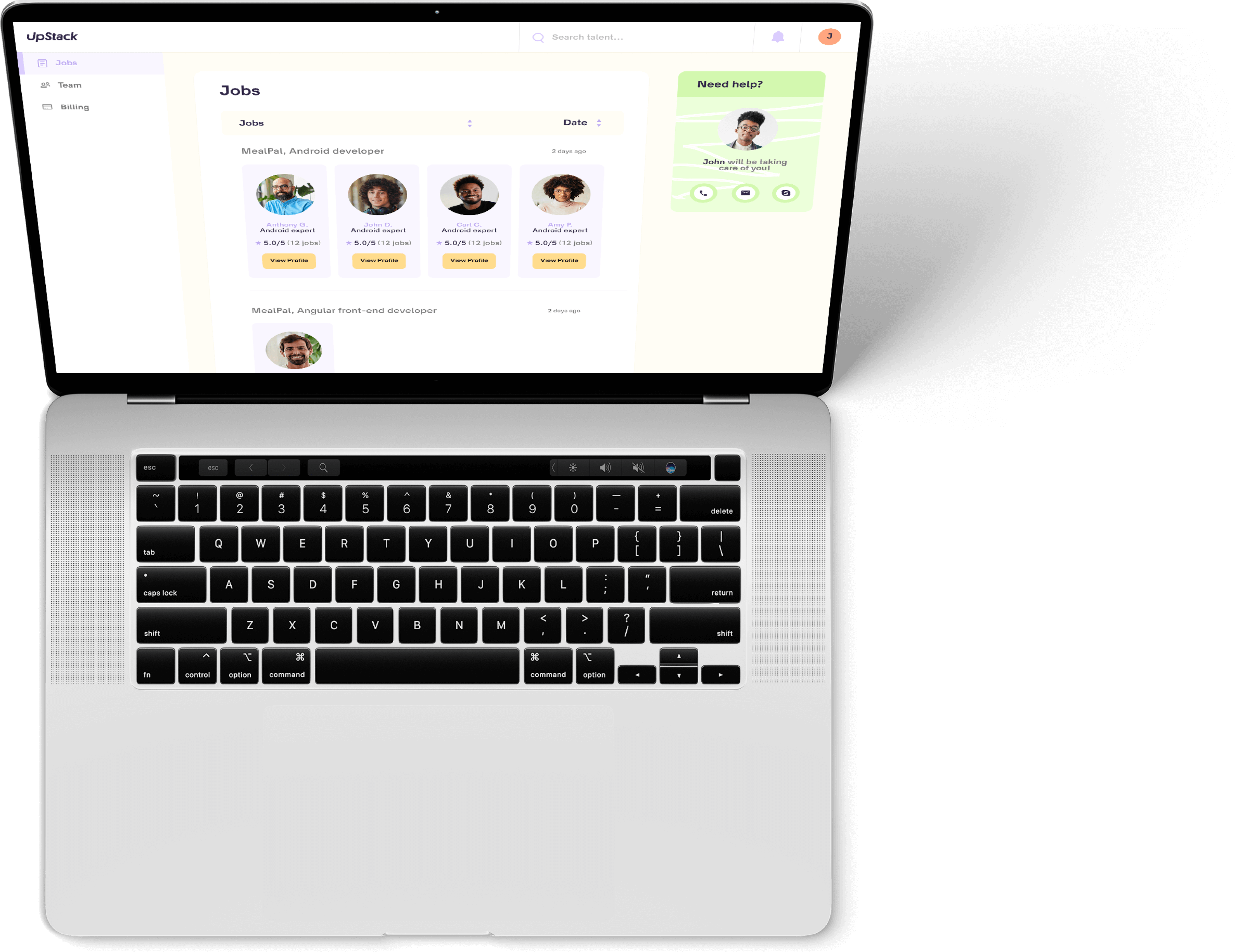


Hire GraphQL Developers Remotely {Devs Ready!}
Stella B.
Available
GraphQL Developer
-
Experienced Graphql engineer with seamless project implementation
-
Loves guacamole & hates spoilers

-
Marcus T.
Available
GraphQL Engineer
-
Stacked portfolio of beautiful, functional websites
-
Known for his epic charcuterie & cheese boards

-
David M.
Available
Mobile Developer
-
Mobile engineering guru with a knack for translating stakeholder needs
-
Would rather be diving Palau's Blue Corner

-
Top GraphQL Developers with UpStack
Hire GraphQL Developers with UpStack
GraphQL is a powerful query language that can be used to create an efficient and effective data layer for your web application. As a result, choosing the right GraphQL programmer for your project is essential to ensure you get the best results. It’s important to take the time to consider the skills and experience of potential developers to make sure they are the right fit for your project. You should also consider their communication skills, understanding of the GraphQL language, and ability to work with a team. By researching the right GraphQL programmer, you can ensure that your project is successful and that you get the most out of the technology.
What is GraphQL?
GraphQL is a query language that can be used to create an efficient data layer for your application. It allows developers to specify the data that they need to run their application. Data can be retrieved from a single endpoint, making it easy to integrate with other systems and applications. It is not similar to SQL, which is a language used to query data stored in a database. Instead, it is a language used to describe what data is needed by the application and how that data should be structured. This means that the data needs to be structured in a certain way before it can be used with GraphQL. This is known as “schema” and is written using GraphQL syntax. With GraphQL, developers can specify multiple queries that return different types of data. When one query fails, the application can fall back and use another query to get the data it needs.
Benefits of using GraphQL
There are many benefits to using GraphQL for your application. A key benefit is that it provides a single endpoint for all data. This means that the data for the entire application is stored in one place, which makes it easier to change and update. Additionally, it allows a single API endpoint to query multiple data sources. This means that you can use GraphQL to get data from a database, external API, or data stored in a file system. Another benefit is that it is highly efficient. This is because it allows data to be cached and retrieved quickly. The data can also be changed quickly and easily. This makes it ideal for real-time applications. Another benefit is that it is secure. It uses a token-based authentication method that provides secure access to the data.
What to look for in a GraphQL developer
When hiring a GraphQL developer, there are a number of things you should look for. This will help you to find the right person for your project and ensure that they are able to complete the task to the highest standard. You should look for a developer who has experience using the technology. This will help them to use it efficiently and effectively to meet your project requirements. You should also look for someone who can work well within a team. This is important for helping the developer to integrate with your team and use the technology effectively. You should also look for someone who has ample experience working with GraphQL. This is important for making sure that the developer can use it to its full potential and create an effective data layer. It’s also helpful to look for a developer who has experience with other technologies. This can help them to integrate with your existing technology and architecture. It can also make the process of hiring a GraphQL programmer easier, as you can find developers with the right skills and experience for your project.
Understanding the GraphQL language
Before you start hiring developers, it’s important to understand the GraphQL language. This will help you to identify candidates who have the right skills and experience. It’s also important to make sure that you understand the data requirements before you start hiring developers. This means that you should have a clear understanding of how your data will be structured. This will make it easier to find developers who can use the technology effectively. It’s important to understand the structure and syntax of the language. This will help you to understand what skills are needed to use the technology effectively. It will also help you to identify candidates who are the right fit for your project.
Being able to work with a team
It’s important to consider the team skills of potential developers. You should look for developers who have experience working with teams and can fit in with your company culture. Being able to work with a team is essential for using GraphQL effectively. It’s important for developers to be able to communicate with each other effectively. This will make sure that the team works well together, and that the technology is used to its full potential. It’s also important for developers to be able to communicate with other teams working on the project. This will help them to integrate with your existing architecture and technology. It will also make it easier for different teams to work together effectively and efficiently.
Communication skills
Communication skills are essential for finding the right developers for your project. This is because it will help you to find programmers who will work well within your team and use the technology effectively. This is important for both the short-term and long-term success of your project. Good communication skills will help developers to work together, create effective solutions, and meet project deadlines. They will also help them to use the technology effectively and efficiently. This will make the team more productive and help to meet project deadlines. It’s important to look for programmers who have good communication skills. This will help them to work within your team effectively and efficiently. It will also make it easier for them to integrate with your architecture and technology.
Portfolio of work
When hiring a GraphQL developer, you should look at their portfolio of work. This will help you to get a better idea of their technical skills and how they work. It will also help you to find out what types of projects they have worked on in the past. It’s important to look for examples that are similar to your project. This will help you to get a better idea of how the developer works and how they use the technology. It will also help you to find out how long projects take for them to complete. This will help you to determine their work rate and see if they are able to meet your project deadlines.
Understanding of data modeling
When creating a data layer, it’s important to understand data modeling. This will help you to create an efficient data architecture that meets project requirements. It’s important to understand both relational and non-relational data models. This will help you to create an efficient data layer that is easy to maintain and update. It’s important to look for developers who understand data modeling. This will make it easier to create an efficient data layer and meet project requirements. It will also help you to avoid potential issues and problems with the data layer. It’s important to make sure that the data layer is designed effectively. This will make it easier to use and update. It will also help to reduce maintenance costs.
Knowledge of GraphQL libraries and frameworks
When hiring a GraphQL programmer, it’s important to look for experience with GraphQL libraries and frameworks. This will make it easier to create an effective data layer. It will also make it easier to integrate with your existing architecture and technology. It will also help you to save time and resources by avoiding the need to build everything from scratch. It’s important to look for experience with libraries and frameworks that are relevant to your project. This will make it easier to integrate the technology with your architecture and existing technology. It will also help to save time and resources.
Experience with other web technologies
When hiring a programmer, it’s important to look for experience with other web technologies. This will help them to integrate with your existing architecture and architecture. It will also help them to use the technology effectively and efficiently. It’s important to make sure that the developer is well rounded and has experience with other technologies. This will help them to integrate with your company culture and architecture. It will also help them to use the technology effectively and efficiently.
They trust Our Graphql Developers
Why hire a Graphql developer with UpStack
![Graphql Developer and Programmer]()
Top Graphql talent pre-vetted for a perfect fit.
Our 8-point assessment evaluation ensures that every senior Graphql developer you interview exceeds expectations across technical, cultural, and language criteria.
![Graphql Programmers Computer Icon]()
Hire reliable, passionate Graphql developers.
From late-night sprints to jumping on a last-minute face-to-face, we ensure that your recruits are down to get the job done right.
![Graphql Programmers High Five Icon]()
Risk-free 14-day trial.
Confidently onboard candidates with our no-questions-asked trial period. We'll walk you through the contract-to-hire process if and when you're ready to make it permanent with your new Graphql engineer.
![Graphql Computer Programmer Icon]()
Our Client Success Experts provide white-glove service.
Stay laser-focused on your business goals while our team of experts curates potential candidates and manages seamless programmer onboarding.
![Graphql Developer Writing Notes Icon]()
Build your optimal team confidently, quickly.
UpStack handles everything including background and reference checks, legal issues, and more. Our platform streamlines billing, timesheets, and payment all in one easy-to-access place.
Schedule a call with a Client Success Expert to get starting hiring a Graphql developer.
Start hiring Start hiring Start hiring
Hire from the Best.
Working with our Client Success Experts, we'll help you build the remote team of your dreams with top Graphql talent from around the world.
Pre-vetted, reliable Graphql developers are standing by.





Hiring Graphql Developers | FAQs
How much does it cost to hire a Graphql developer?
UpStack has a simple billing model where each Graphql developer has a standard hourly rate averaging between $65-$75 per hour. Rates are based on skills, knowledge, and experience, and our developers are available mainly for full-time engagement (40 hours per week) and the occasional part-time opportunity (20 hours per week).
What is the process to find a Graphql developer?
You'll connect with an UpStack Client Success Manager to determine your immediate needs. Our team uses a combination of AI and personal assessment to short-list candidates that match your job requirements. From there, you interview, select, and onboard the perfect developer, all within days of your initial call.
How does UpStack find its Graphql developers?
UpStack's talent recruitment team connects with software developers around the globe every day. Each Graphql programmer is vetted for technical, communication, and other soft skills necessary for a developer to successfully work with your team. Once vetted, the candidates are accepted into the UpStack developer community.
How is UpStack different from an agency or recruiter?
UpStack's community of available, pre-vetted engineering talent means minimizing roadblocks to scaling your team effectively, efficiently, and immediately. Our Client Success Experts work with you and your UpStack developer to ensure a smooth and seamless engagement.
Can I hire UpStack Graphql developers directly?
Yes, you can hire UpStack Graphql developers at any time, and with the same assurance of smoothly on boarding talent risk-free. First, we'd create a job opening on our portal. Then, we'd vet, interview, and match developers that meet your needs. If you're satisfied at the end of the 14-day trial period, at any time you can directly hire them.
Common GraphQL FAQs
What is GraphQL?
GraphQL is a query language for your API that was developed and open-sourced by Facebook. It provides a flexible and efficient way to request data from an API and is particularly well-suited for modern, data-driven applications that need to be able to request specific data and receive only the data they need. GraphQL allows developers to specify the data they want to retrieve in a single request, rather than having to make multiple requests to different endpoints. This can improve the performance and efficiency of an API, as well as the developer experience. In GraphQL, an API is defined using a schema, which specifies the types of data that can be queried and the relationships between those types. Developers can then use GraphQL to send queries to the API and receive a response in a predictable and flexible format. GraphQL is increasingly being used as an alternative to REST (Representational State Transfer) APIs, and it is supported by a growing number of backend technologies and front-end frameworks. It is particularly popular among developers who are building modern, data-driven applications that require flexible and efficient data fetching.
What is Apollo GraphQL?
Apollo is an open-source toolkit that provides a set of libraries and tools for building GraphQL applications. It is designed to make it easy to build and manage GraphQL APIs, as well as to integrate GraphQL into existing applications. The Apollo toolkit includes a range of libraries and tools that are designed to support different stages of the development process, including:
- Apollo Server: A GraphQL server library that is used to build and deploy GraphQL APIs.
- Apollo Client: A GraphQL client library that is used to consume GraphQL APIs from a client-side application.
- Apollo Studio: A cloud-based platform for managing and optimizing GraphQL APIs.
- Apollo Engine: A cloud-based platform for monitoring, analyzing, and optimizing GraphQL APIs in production.
Overall, Apollo is a powerful toolkit for building and managing GraphQL applications, and it is used by companies of all sizes to build modern, data-driven applications. It is particularly well-suited for building applications that require flexible and efficient data fetching, and it is supported by a growing number of backend technologies and front-end frameworks.
Is GraphQL faster than REST?
It can be difficult to compare the performance of GraphQL and REST directly, as the performance of an API will depend on a number of factors, including the specific implementation of the API, the complexity of the data being queried, and the workload of the server. However, in general, GraphQL has the potential to be more efficient than REST in certain situations. One of the main benefits of GraphQL is that it allows developers to request only the data they need, rather than having to make multiple requests to different endpoints to retrieve different pieces of data. This can reduce the number of round trips that are required to retrieve data, which can improve the overall performance of an API.
In addition, GraphQL allows developers to specify exactly the data they want to retrieve in a single request, which can reduce the amount of unnecessary data that is transferred over the network. This can also improve the performance of an API, particularly in situations where the data being queried is complex or large. However, it is important to note that GraphQL may not always be faster than REST, and the performance of an API will depend on a variety of factors. It is always a good idea to measure the performance of your API and to optimize it as needed to ensure that it meets the needs of your application.
Is GraphQL frontend or backend?
GraphQL is a query language for APIs that can be used to build both front-end and back-end applications. It is designed to provide a flexible and efficient way to request data from an API, and it is particularly well-suited for modern, data-driven applications that need to be able to request specific data and receive only the data they need. On the front-end, GraphQL can be used to consume data from a GraphQL API, and it is supported by a growing number of front-end frameworks and libraries, including React, Angular, and Vue.js. On the back-end, GraphQL can be used to build and deploy GraphQL APIs, and it is supported by a range of backend technologies, including Node.js, Java, and Python.
Overall, GraphQL is a query language that is used to build both front-end and back-end applications, and it is particularly well-suited for modern, data-driven applications that require flexible and efficient data fetching. It is supported by a growing number of frameworks and technologies and is used by companies of all sizes to build a wide range of applications.
What is fragment in GraphQL?
In GraphQL, a fragment is a reusable piece of a GraphQL query that allows you to specify a set of fields that can be included in multiple queries. Fragments are used to avoid duplication and to make it easier to maintain GraphQL queries. Here is an example of how a fragment can be used in a GraphQL query:
Copy codefragment UserFields on User { id name email } query GetUser { user(id: 1) { ...UserFields} } query GetUsers { users { ...UserFields } }In this example, the UserFields fragment is defined as a set of fields that can be included in a User type. The GetUser and GetUsers queries both use the UserFields fragment to include the id, name, and email fields in their queries. Fragments are a useful tool for avoiding duplication and making it easier to maintain GraphQL queries, and they are particularly useful when working with large or complex GraphQL schemas. They can help to make your queries more readable and maintainable, and they can improve the overall performance and efficiency of your GraphQL API.















